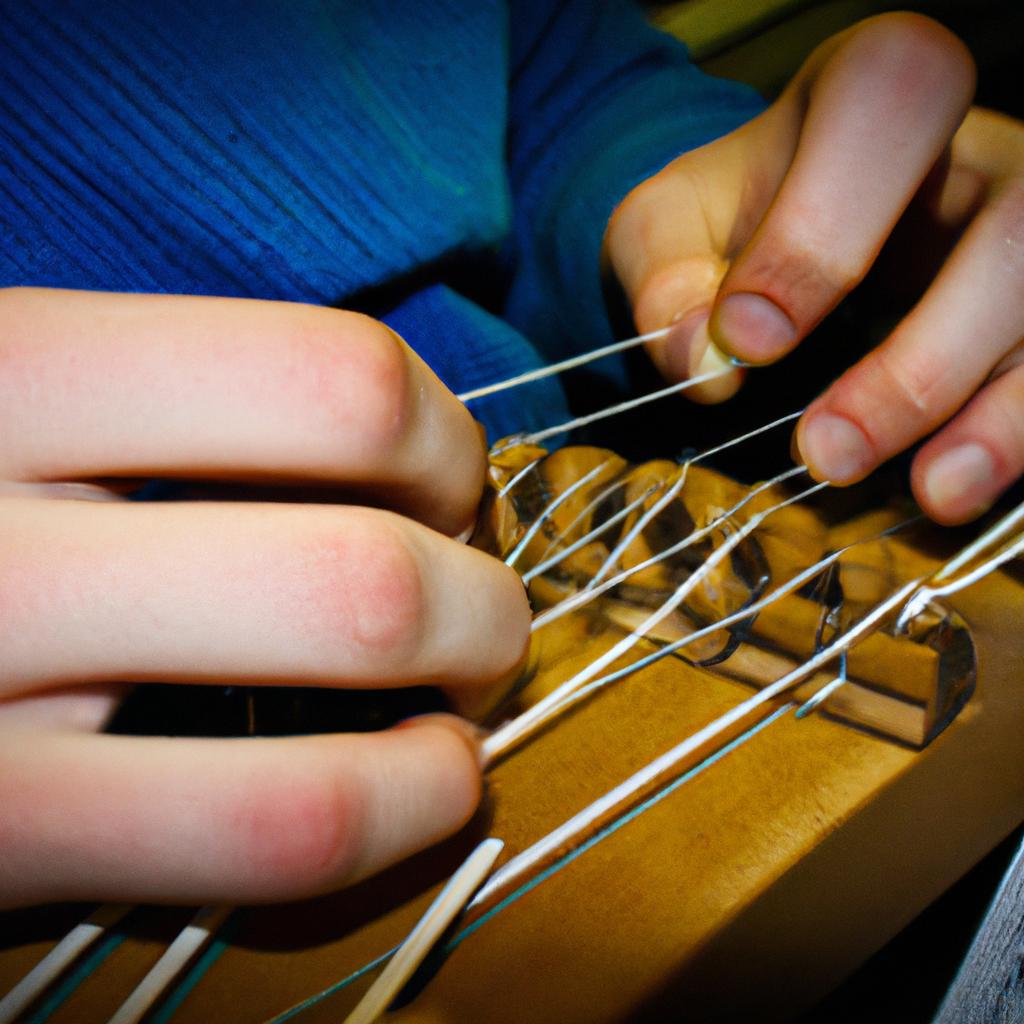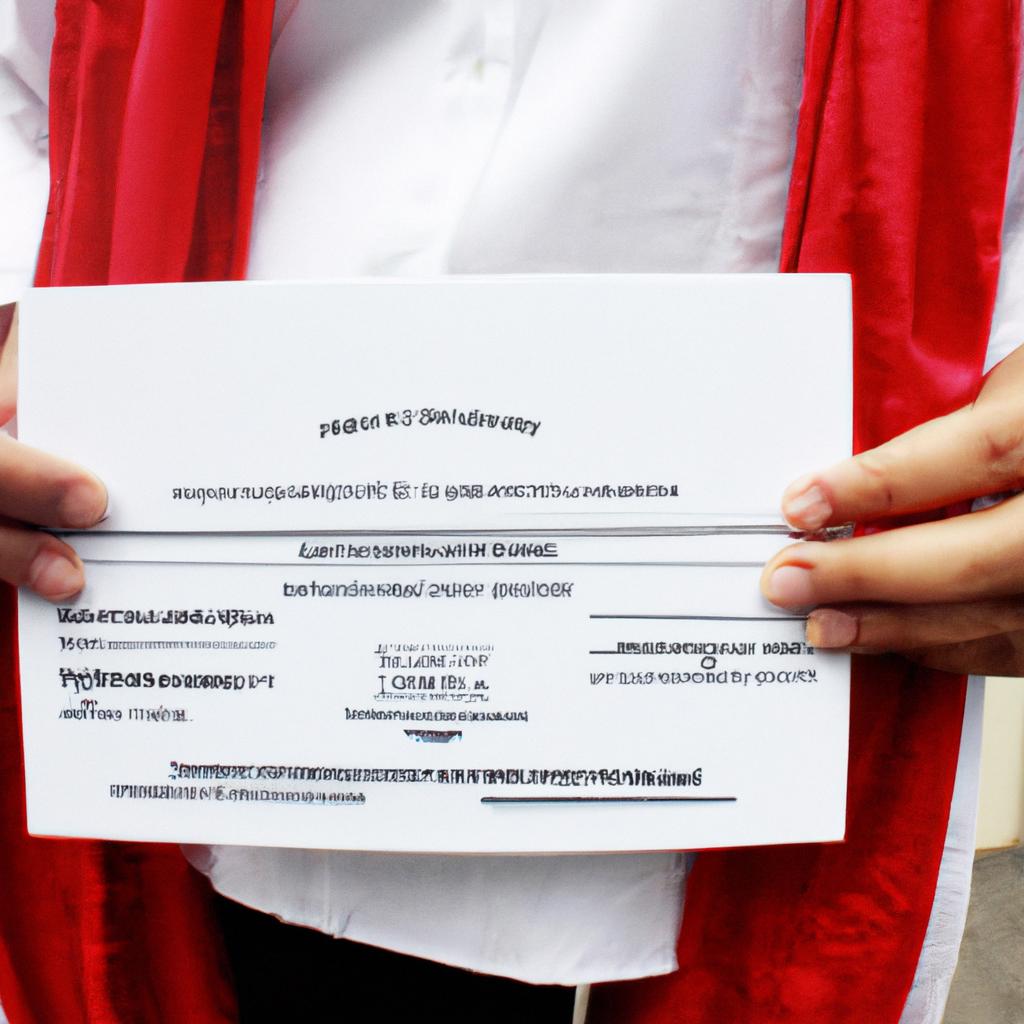Ethnomusicology, a subfield of musicology that explores the cultural and social aspects of music, has gained increasing recognition as an essential component in music education. By delving into the diverse musical traditions across different cultures, ethnomusicologists provide valuable insights and resources for educators seeking to broaden their students’ understanding and appreciation of music. This comprehensive guide aims to present an overview of ethnomusicological approaches within the context of music education, offering practical strategies and examples for incorporating this interdisciplinary field into pedagogical practices.
Imagine a scenario where a high school music teacher is tasked with designing a curriculum that reflects the multicultural backgrounds of their students. The challenge lies not only in selecting appropriate repertoire but also in fostering cross-cultural dialogue and developing intercultural competency among students. Ethnomusicology offers invaluable tools and perspectives for addressing these challenges by studying how people make meaning through music in various sociocultural contexts. In this article, we explore how ethnomusicological principles can enhance the effectiveness of music education programs, providing teachers with a framework to engage students from diverse backgrounds while promoting inclusivity and cultural awareness.
Understanding Ethnomusicology
Ethnomusicology is a multidisciplinary field that combines the study of music and culture to gain insights into various musical practices across different societies. This section aims to provide an overview of ethnomusicology, highlighting its key concepts and methodologies. To illustrate the relevance of this field, let us consider the case study of a group of music educators seeking to incorporate diverse cultural perspectives into their curriculum.
One fundamental aspect of ethnomusicology is recognizing the diversity in musical expressions present worldwide. As our society becomes increasingly globalized, it is crucial for music educators to acknowledge and appreciate the multitude of musical traditions that exist beyond their own cultural framework. By doing so, they can foster inclusivity and broaden students’ understanding of music as a universal language.
To fully grasp the significance of ethnomusicology in music education, it is essential to explore some key points:
- Music as a reflection of cultural identity: Different cultures use music as a means to express their unique identities and values.
- Interactions between music and social contexts: Music plays a significant role within societal structures, such as religious ceremonies or political events.
- Preservation and documentation: Ethnomusicologists strive to document endangered musical traditions before they disappear completely.
- The impact on individual experiences: Studying diverse musical practices enhances individuals’ appreciation for other cultures while deepening their self-awareness.
The following table provides examples from different regions around the world that exemplify how ethnomusicology contributes to enriching our knowledge about various musical traditions:
| Region | Musical Tradition | Key Features |
|---|---|---|
| Africa | Mbira (Zimbabwe) | Polyphonic texture |
| Asia | Qawwali (Pakistan) | Sufi devotional singing |
| Americas | Samba (Brazil) | Rhythmic complexity |
| Oceania | Haka (New Zealand) | Powerful dance and chants |
By understanding ethnomusicology, music educators can effectively explore the cultural context of different musical traditions. This exploration allows them to engage students in a meaningful way, fostering appreciation for diversity and promoting cross-cultural understanding through music education. In the subsequent section, we will delve into how this understanding can be applied practically within educational settings, providing strategies for incorporating diverse musical perspectives while respecting cultural sensitivities.
Exploring Cultural Context in Music
As we delve deeper into the realm of ethnomusicology, it becomes evident that understanding the cultural context of music is crucial to developing a comprehensive music education curriculum. One example that highlights this significance is the case study of a middle school in a diverse urban community. In this school, students come from various cultural backgrounds and bring with them their own unique musical traditions.
To fully embrace the diversity within the student body, educators must be equipped with knowledge about different cultures’ music practices and beliefs. By doing so, they can create an inclusive environment where all students feel heard and valued. To achieve this goal effectively, here are key points to consider:
- Culturally responsive teaching practices: Educators need to adopt teaching strategies that honor and respect diverse musical expressions while promoting critical thinking skills.
- Building bridges between cultures: Encouraging dialogue among students from different cultural backgrounds fosters mutual understanding and appreciation.
- Recognizing power dynamics: Being aware of power imbalances helps educators navigate potentially sensitive topics related to race, ethnicity, and social hierarchies respectfully.
- Incorporating multiple perspectives: Providing opportunities for students to share their personal experiences with music allows for a richer exploration of varied cultural contexts.
| Strategies for Exploring Cultural Context |
|---|
| 1 |
| 2 |
| 3 |
| 4 |
By embracing these approaches, educators can guide their students towards gaining a more profound understanding of how culture influences music creation, performance, and consumption. This holistic perspective not only enriches the educational experience but also prepares students to become global citizens who appreciate and respect the value of diverse music traditions.
As we explore ways to incorporate diverse music traditions in the classroom, it is imperative to consider practical strategies that allow for meaningful engagement with a wide range of musical cultures.
Incorporating Diverse Music Traditions in the Classroom
As music educators, it is essential to explore the cultural context of music, as this provides a rich foundation for understanding and appreciating diverse musical traditions. By delving into the historical, social, and geographical aspects that shape a particular style of music, we can foster a deeper connection between students and the music they encounter in their classrooms.
For instance, consider an ethnomusicology case study focused on Indian classical music. By examining its origins in ancient scriptures and its evolution through various dynasties, students gain insight into how cultural practices influence musical expression. This exploration also encompasses the socio-political factors that shaped specific genres within Indian classical music, highlighting the intricate relationship between society and artistic development.
To help students navigate these complexities effectively, here are some key approaches to exploring cultural context in music education:
- Encourage active listening: Provide opportunities for students to actively engage with diverse musical styles by incorporating listening exercises into class time.
- Foster empathy: Through discussions and reflection activities, encourage students to empathize with different cultures’ experiences and perspectives embedded within their musical traditions.
- Promote critical thinking: Encourage students to analyze and question societal norms reflected in various musical traditions. This cultivates independence of thought while fostering a deeper appreciation for diversity.
- Facilitate cross-cultural collaborations: Organize collaborative projects where students have the opportunity to work with musicians from different cultural backgrounds. This enables them to experience firsthand the power of collaboration across diverse musical contexts.
By engaging in these strategies, educators create an inclusive learning environment that fosters cultural awareness and respect among students.
| Key Approaches | Benefits | Challenges |
|---|---|---|
| Active Listening | Enhances auditory | Limited access to |
| perception skills | authentic resources | |
| Empathy | Develops emotional | Challenging |
| intelligence and | discussions around | |
| global citizenship | cultural biases | |
| Critical Thinking | Encourages | Resistance to |
| independent thought, | questioning | |
| fosters analytical | cultural norms | |
| skills | ||
| Cross-cultural | Promotes | Communication |
| Collaborations | understanding of | barriers due to |
| diverse perspectives | language or | |
| and collaboration | cultural differences |
In the exploration of cultural context within music education, we lay the groundwork for creating a more inclusive and culturally responsive learning environment. By actively engaging students through active listening, empathy-building exercises, critical thinking activities, and cross-cultural collaborations, educators help cultivate an appreciation for diversity that extends beyond the classroom walls.
Transition into subsequent section: As students develop their understanding of different cultures’ musical traditions, it becomes imperative to engage them further by delving into ethnomusicological research. This allows learners to examine music from various lenses while developing their own unique interpretations and connections.
Engaging Students through Ethnomusicological Research
Building upon the previous section’s focus on incorporating diverse music traditions in the classroom, this section delves into how ethnomusicological research can be utilized to engage students further. By exploring the cultural significance of music from different regions around the world, educators can provide a rich and immersive learning experience for their students.
To illustrate this concept, let us consider an example where students are studying traditional West African drumming. Through ethnomusicological research, they would not only learn about the technical aspects of playing the drums but also delve deeper into the historical and cultural contexts surrounding this musical tradition. This approach allows students to appreciate both the musical intricacies and the broader social implications associated with each musical practice.
Engaging students through ethnomusicological research involves several key strategies:
- Encouraging active participation: Students should have opportunities to actively engage with different musical practices by participating in workshops or performances.
- Promoting critical thinking: Ethnomusicology encourages students to critically analyze and interpret various elements of a musical tradition, such as its instrumentation, rhythmic patterns, and lyrical content.
- Fostering intercultural understanding: Studying diverse music traditions fosters empathy and appreciation for cultures outside one’s own. It helps develop a sense of global citizenship among students.
- Emphasizing interdisciplinary connections: Ethnomusicology naturally lends itself to interdisciplinary exploration since it incorporates aspects of anthropology, history, sociology, and more.
By adopting these strategies, educators can create a transformative learning environment that nurtures curiosity and encourages meaningful engagement with diverse music traditions.
Table: Benefits of Engaging Students through Ethnomusicological Research
| Benefits | Examples |
|---|---|
| Expanded cultural knowledge | Understanding Indian classical ragas or Indonesian gamelan |
| Enhanced empathy | Appreciating Native American ceremonial songs |
| Strengthened critical thinking | Analyzing the polyrhythms in Afro-Cuban music |
| Nurtured creativity and expression | Composing original songs inspired by Middle Eastern maqam scales |
As students delve deeper into different musical traditions through ethnomusicological research, they develop a broader understanding of music’s role in society. This exploration fosters cultural appreciation, empathy, and critical thinking skills. In turn, these experiences lay the foundation for integrating ethnomusicology seamlessly into the music curriculum.
As we move forward to explore how ethnomusicology can be integrated into the music curriculum, it becomes evident that this approach enriches students’ learning journeys beyond traditional pedagogical methods.
Integrating Ethnomusicology into Music Curriculum
As students delve deeper into the study of ethnomusicology, they not only gain a greater understanding and appreciation for diverse musical traditions but also develop their critical thinking skills. By engaging in ethnomusicological research, students have the opportunity to explore different cultural contexts and connect with music on a personal level. This section will discuss how educators can effectively integrate ethnomusicology into music curriculum to engage students in meaningful ways.
One example that highlights the power of ethnomusicological research is a case study conducted at a high school where students were asked to investigate traditional West African drumming techniques. Through hands-on experiences such as playing traditional drums and learning about the cultural significance behind each rhythm, students gained a deep appreciation for this particular musical tradition. Furthermore, by analyzing recordings and studying transcriptions of West African rhythms, they were able to make connections between these traditions and contemporary popular music styles.
To effectively integrate ethnomusicology into music curriculum, educators can consider the following strategies:
- Encourage active listening: Provide opportunities for students to listen to various genres of music from around the world and guide them in reflecting upon the cultural context in which it was created.
- Incorporate authentic performance experiences: Invite guest musicians or groups from different cultural backgrounds to perform for students, allowing them to witness firsthand the beauty and complexity of global musical traditions.
- Foster cross-cultural collaborations: Facilitate collaborations between students from different cultural backgrounds, encouraging them to share their own musical practices and create new compositions together.
- Emphasize interdisciplinary connections: Highlight how ethnomusicology intersects with other disciplines such as anthropology, sociology, history, and linguistics, providing students with a broader perspective on music’s role in society.
By employing these strategies within music education settings, educators can nurture curiosity among students while promoting empathy and respect for diverse cultures. The table below illustrates some key benefits associated with integrating ethnomusicology into music curriculum:
| Benefits of Integrating Ethnomusicology in Music Curriculum |
|---|
| – Enhanced cultural understanding and appreciation. |
| – Development of critical thinking skills through analysis and interpretation of diverse musical traditions. |
| – Promotion of empathy, respect, and inclusivity among students towards different cultures. |
| – Encouragement of creativity by exploring new musical styles and techniques. |
In the subsequent section on “Benefits of Ethnomusicology in Music Education,” we will further explore how incorporating ethnomusicological perspectives can enrich students’ overall learning experience and foster a deeper connection with music from around the world.
Note: Please remember to insert the actual bullet point list and table using markdown formatting when integrating this response into your document.
Benefits of Ethnomusicology in Music Education
By integrating ethnomusicology into music curriculum, students gain a deeper understanding and appreciation for diverse musical traditions. This enables them to explore various cultural contexts and broaden their horizons beyond conventional Western perspectives. In addition to fostering multicultural awareness, incorporating ethnomusicological approaches can also enhance students’ musicianship skills and promote creativity.
Benefits of Ethnomusicology in Music Education:
Engaging with Diverse Cultures:
Imagine a classroom where students are exposed to the rich soundscape of different cultures around the world. For instance, through an ethnomusicological lens, students may study traditional African drumming techniques alongside Indonesian Gamelan orchestras. By exploring these diverse musical traditions, students develop respect for cultural differences and cultivate empathy towards others.
- Appreciation for global diversity
- Heightened awareness of cultural heritage
- Encouragement of open-mindedness
- Promotion of inclusivity and tolerance
Table – Examples of World Musical Traditions:
| Region | Traditional Genre | Instrumentation |
|---|---|---|
| Africa | Mbira | Djembe |
| Asia | Raga | Erhu |
| Latin America | Samba | Charango |
Through this culturally inclusive approach, educators foster curiosity about the world’s diverse musical expressions and nurture a sense of belonging within each student. Furthermore, embracing ethnomusical practices allows learners to challenge preconceived notions about what constitutes “valid” or “superior” forms of music.
Promoting Critical Thinking Skills:
Incorporating ethnomusicology in music education not only exposes students to new sounds but also encourages critical thinking. Through comparative analysis of different musical traditions, students develop analytical skills and learn to identify commonalities and differences across cultures. This process promotes a deeper understanding of music as a social phenomenon that reflects historical, cultural, and political contexts.
By integrating ethnomusicology into music education, educators empower students to think critically about the world around them. They are encouraged to question dominant narratives in music history and challenge stereotypes associated with certain musical genres or cultures. As a result, students become more informed global citizens who appreciate the intricacies of human expression through sound.
In summary:
Ethnomusicology offers numerous benefits when integrated into music education. By engaging with diverse musical traditions from around the world, students gain an appreciation for cultural diversity while developing crucial musicianship skills. Moreover, this approach fosters critical thinking skills by encouraging comparative analysis and challenging conventional perspectives on music. Ultimately, incorporating ethnomusicological approaches enriches both the educational experience and personal growth of students within a dynamic multicultural society.
 Mikey Dee
Mikey Dee



